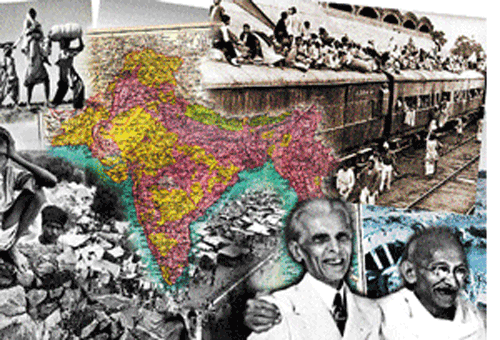Contributors from India, Pakistan and Bangladesh have helped stitch up a melange of reflective, witty and contemporary accounts of how ordinary people negotiated with the Partition, in a new graphic novel.
Narratives by 46 contributors - journalists, graphic artists, translators and storytellers among others- feature in the anthology "This Side That Side: Restorying Partition" (Yoda Press) scheduled for release on August 30.
"The idea was to explore Partition and its effect on contemporary times through medium of comics and graphic narratives. Hence a visual perspective was critical," Vishwajyoti Ghosh, who curated the anthology says.
The book contains 28 narratives- poetry, songs, dastans, reportage- all rendered in different visual styles and forms.
"Many narratives were also translated from Hindi, Urdu, Bengali in English," Ghosh says.The graphic narratives are presented from the point of view of various now middle-aged people, who did not witness the 1947 Partition but grew up on it.
Graphic narratives reflect how people negotiated with the epochal moment of Partition, which brought with it tremendous amount of loss, pain and despair.
A narrative titled "Tamasha-e-Tetwal", one of the many stories brought together in the anthology reads thus:
"Tetwal a village located at Line of Control (LoC). Post partition in 1947, two settlements emerge demarcating the two countries. What divides one settlement from the other is a rivulet. Despite the barriers, people still talk to one another, they are curious to know what's happening on the other side even when they may not sit together."
The anthology attempts to look beyond what has already been written about Partition since 1947, roping in both non-fiction and fiction.
It has moved further, collated more reflective, witty and contemporary accounts of Partition.
It all began when Arpita Das, publisher of Yoda Press wanted to come up with a graphical representation of Partition two-and-a-half years ago with the idea soon attaining shape when Yoda Press partnered with the Goethe Institute.
"The next task was to look for content. We knew it wouldn't be a single author initiative. Multiple stories had to be told, numerous perspectives had to be brought in. After all, these borders were man-made," Arpita recalls.
When approached with the idea of "This Side That Side," graphic novelist, cartoonist and designer Vishwajyoti Ghosh says he readily agreed.
"Much before 'Delhi Calm', which re-imagines Delhi in the 1970s, one of the earliest graphic novels I had ever set out to write was actually on Partition. While working on it I realised how such a moment in history can only be ever told through multiple stories and even more.
"It was a book I wanted to write but through many more voices and their stories. When I was offered this book, it was a yes without a blink," Ghosh says.
The publisher soon called for entries from India, Pakistan and Bangladesh. A lot of contributions were received over e-mail from Pakistan. Additionally, Goethe Institute with Vishwajyoti conducted a week-long workshop in Dhaka to procure fresh perspectives.
"When we talk about Partition, one often tends to forget Bangladesh. The country was partitioned twice, therefore it was important to bring in stories of Bangladeshis," Arpita says.
Designing the cover for the anthology was a challenge.
"The cover was to be a culmination of the entire process. While working on the anthology one came across the levels of curiosity, energy and interest to engage with a theme like Partition. Thus, I came up with mirror image, typographically reminiscent of how people across the border stand on their sides looking at each other, wanting to connect," Ghosh says.
The anthology, termed as the most important title for Yoda Yoda Press, an independent publishing house based in Delhi which was formed 10 years ago.
